![Male Neogurelca montana taihangensis (upperside), Huangshandian Village, Shangfangshan National Forest Park, Fangshan District, Beijing, China, 13.ix.2022, 130m [HOLOTYPE]. Photo: © Xu ZhenBang. Male Neogurelca montana taihangensis (upperside), Huangshandian Village, Shangfangshan National Forest Park, Fangshan District, Beijing, China, 13.ix.2022, 130m [HOLOTYPE]. Photo: © Xu ZhenBang.](n_tai_c1.jpg)
![Female Neogurelca montana taihangensis (upperside), Baihua Shan National Nature Reserve, Mentougou District, Beijing, China, x.2018, 1400m [PARATYPE]. Photo: © Xu ZhenBang.. Female Neogurelca montana taihangensis (upperside), Baihua Shan National Nature Reserve, Mentougou District, Beijing, China, x.2018, 1400m [PARATYPE]. Photo: © Xu ZhenBang.](n_tai_c2.jpg)
![Male Neogurelca montana taihangensis (underside), Huangshandian Village, Shangfangshan National Forest Park, Fangshan District, Beijing, China, 13.ix.2022, 130m [HOLOTYPE]. Photo: © Xu ZhenBang. Male Neogurelca montana taihangensis (underside), Huangshandian Village, Shangfangshan National Forest Park, Fangshan District, Beijing, China, 13.ix.2022, 130m [HOLOTYPE]. Photo: © Xu ZhenBang.](n_tai_c3.jpg)
![Female Neogurelca montana taihangensis (underside), Baihua Shan National Nature Reserve, Mentougou District, Beijing, China, x.2018, 1400m [PARATYPE]. Photo: © Xu ZhenBang.. Female Neogurelca montana taihangensis (underside), Baihua Shan National Nature Reserve, Mentougou District, Beijing, China, x.2018, 1400m [PARATYPE]. Photo: © Xu ZhenBang..](n_tai_c4.jpg)
Neogurelca montana taihangensis Xu & He, 2023, Insects, 14(10): 818 [10/26 pp.]. Type locality: China, Beijing, Fangshan District, Huangshandian Village, 130m.
Wingspan: 38-44mm. Size similar to the nominotypical subspecies but can be distinguished by the following characters: (1) in Neogurelca montana taihangensis body and forewing paler than in Neogurelca montana montana (Rothschild & Jordan, 1915); (2) the yellow patches of the hindwing of Neogurelca montana taihangensis are triangular shaped, with a more distinct outer boundary; and (3) the anterior boundary of patagium in Neogurelca montana taihangensis is fuzzier than that of the nominotypical subspecies. Male genitalia same as in Neogurelca montana montana, but the width of the transverse apical process of the phallus in Neogurelca montana taihangensis is narrower than that of the nominotypical subspecies (Xu, He, Yang, Kitching & Hu, 2023).
Unlike Neogurelca montana montana in Yunnan and Tibet, adults of this subspecies rarely appear in numbers. Around Beijing, adults fly in low mountainous areas and urban parks at 100 m altitude, but also in mountains at 1500 m, but always where Leptodermis oblonga Bunge (the larval hostplant) is present (Xu, He, Yang, Kitching & Hu, 2023).
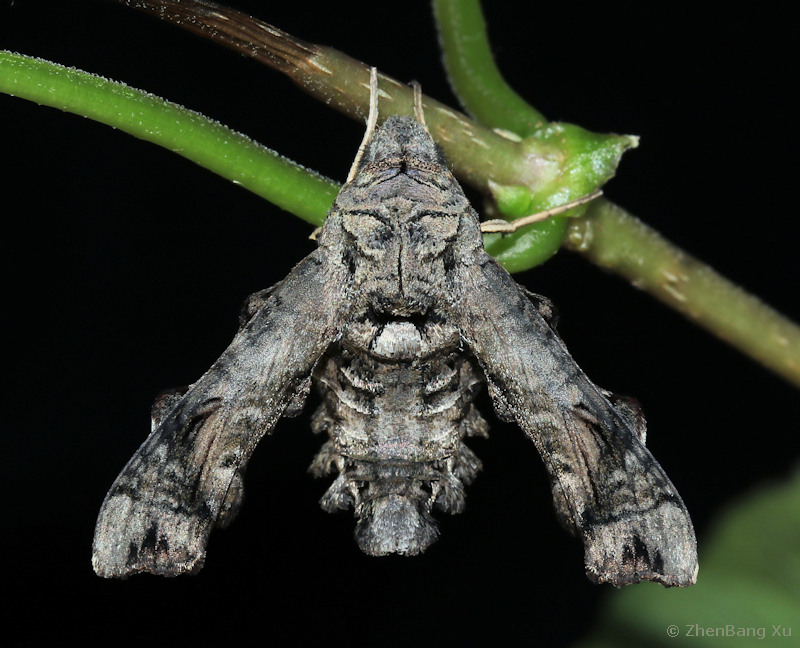
June to October (Xu, He, Yang, Kitching & Hu, 2023).
OVUM: Unrecorded.
LARVA: Polychromatic. Identical to that of Neogurelca montana montana as illustrated by Bell & Scott (1937, ex Mell), with an all green, green with brown patches, and brown form. Body dull, smooth, and cylindrical, thoracic segments flared laterally into flanges. Surface of head dull and set with short, curved, translucent hairs, each rising from a minute tubercle. In the green form, head green with a pale yellow/white stripe separating face from cheek. Green of the body speckled with pale yellow/white spots, and with a pale yellow/white subdorsal stripe from segment 2 to base of horn (and thence on to segment 13), enclosing a rust-brown dorsal patch behind horn in some. There are seven pale oblique lateral stripes, the angles formed by the junction of these stripes with the subdorsal stripe filled in with rusty-brown patches in some. In some, the subdorsal stripe may be edged above with rusty-brown near these junctions. True legs pale green, rusty-red medially. Spiracles black with a white, dumbbell-shaped central slit. According to Bell & Scott (1937, ex Mell), in the final instar the horn is of medium length, slightly up-curved, with fine tubercles, tip broadly bifid. This is slate-coloured with a pale, yellowish ring beyond the middle, and a purple/reddish base. This is waved up and down when the larva is disturbed, or when walking, a behaviour also found in other members of the genus (YuChen Zhang, pers. obs. 2023).
The purple/brown form is very different in the final instar. The head and body are basically plum-coloured, darker ventrally, and covered with paler spots. The cheek stripe and subdorsal stripe is diffuse white with brown (sometimes orange) inclusions. The pale oblique lateral stripes are bright white, obviously broader below the spiracles, with the angles formed by the junction of these stripes with the subdorsal stripe filled in with diffuse orange patches in some. True legs purple/black. Spiracles black with a white, dumbbell-shaped central slit. The horn is reddish/purple with the apical quarter blackish, with a yellowish ring beyond the middle in some (YuChen Zhang, pers. obs. 2023).
All larvae turn deep purple prior to pupation (Xu, He, Yang, Kitching & Hu, 2023).
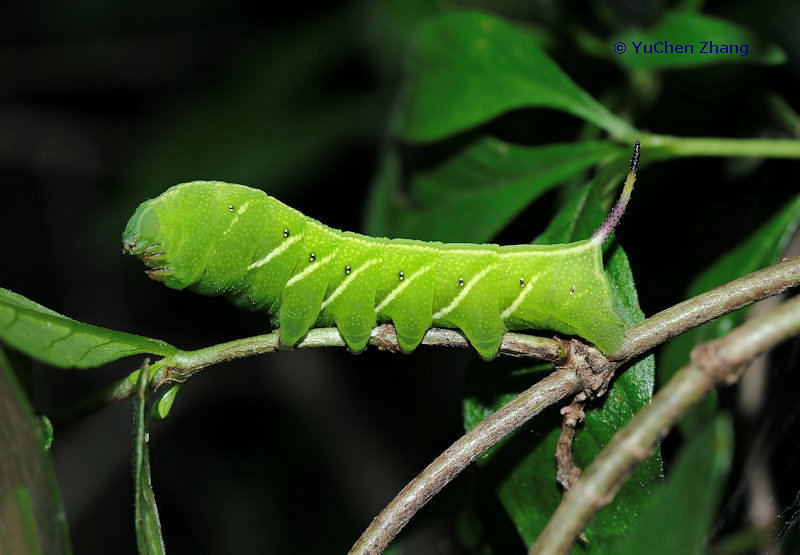
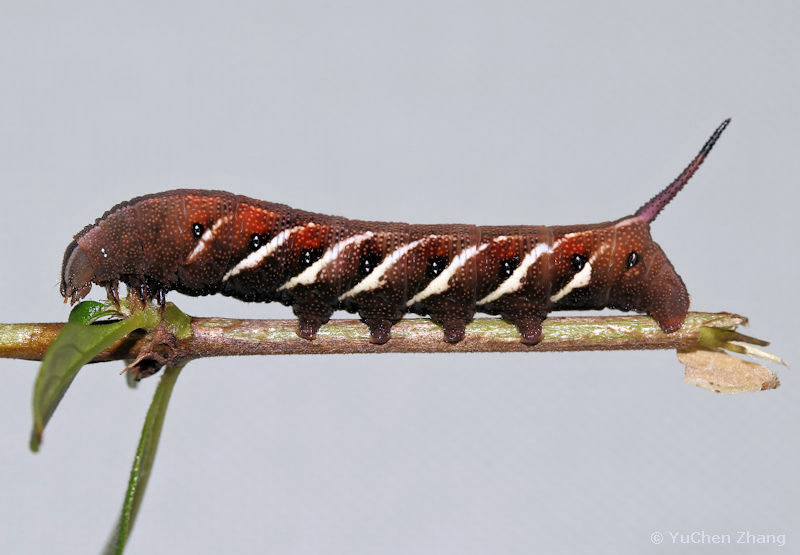
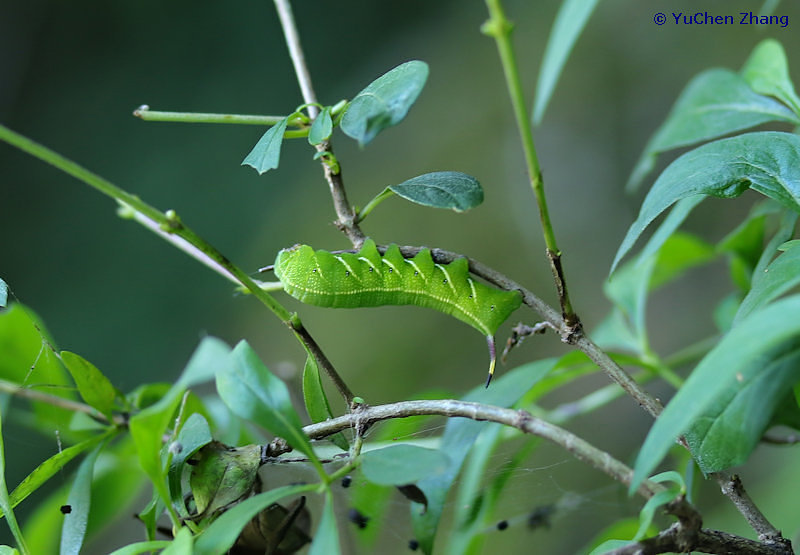
PUPA: 23mm. Very similar to that of Neogurelca himachala (Butler, [1876]). Colour ochreous but transluscent, with the developing adult clearly visible through the cuticle. Head, tongue, wing-case, legs, antenna and thorax with regular interrupted transverse bars of leaden colour. Intersegmental cuticle of movable segments 8, 9 and 10 deep chestnut. All spiracles and shaft of cremaster dark brown/black, with the spiracles lying on black patches. Stoutish in build, somewhat shiny, and not very mobile. Head mildly elongate but rounded in front; toungue-case not projecting and flush with the surface of the body; shoulders prominent. Antenna shorter than fore leg, and there is a well-developed coxal piece. Head with vertex. Thorax superficially, transversely, irregularly lined. Wing-case smooth, bulging ventrally, thus giving the pupa a 'beer-belly', but not so pronounced as in Neogurelca himachala. Abdomen smooth except for very superficial transverse folds and pits. There is some sculpturing on segment 4 consisting of a small transverse subdorsal weal just behind the front margin, and a small pit above and behind the spiracle of 6. The spiracles of 9, 10 and 11 are situated on the hind face of a ridge running round the front margins of those segments. Segment 9 has small, irregular, ante-spiracular ridges. Spiracle of 2 covered by a rounded lobe projecting from the front margin of 3, its front edge raised. Remaining spiracles broadly oval, edges of central slit raised. Cremaster very short, conical, ending in a short, stout, cylindrical shaft bearing about twelve very short-stemmed anchor-shaped hooklets.
Formed in leaf litter on the ground, with a few thick strands of gummy silk used to hold the plant debris together to create a cocoon-like 'chamber', but leaving part of the fold open frontad. Duration of pupa = 14 days in the autumn (Xu, He, Yang, Kitching & Hu, 2023).
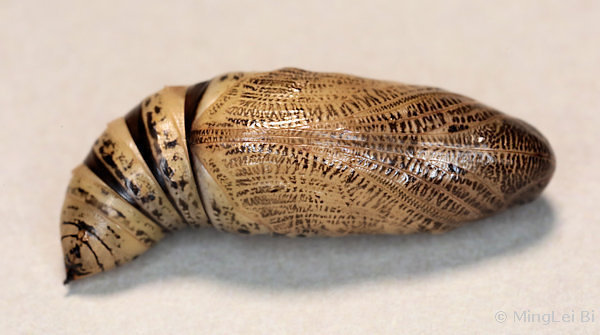
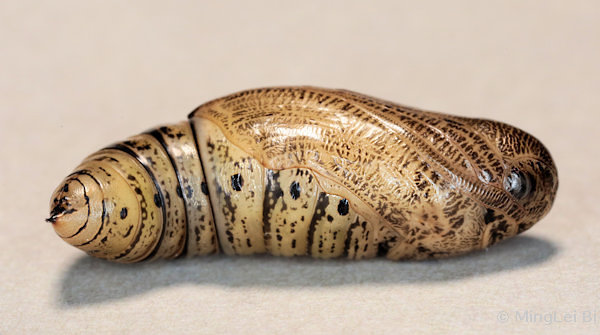
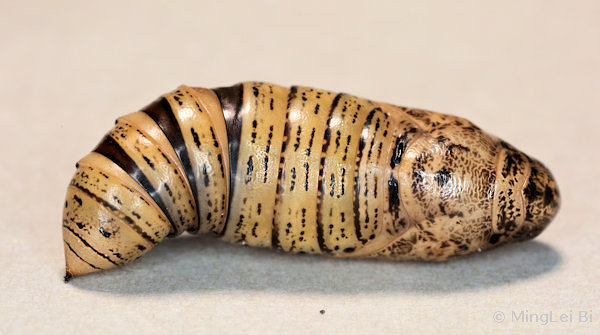
Larval hostplants. In China on Leptodermis oblonga Bunge around Beijing (Xu ZhenBang, pers. comm. 2022; Xu, He, Yang, Kitching & Hu, 2023). This plant is a small shrub growing up to 60-150 cm, which can be found growing on rocky cliffs and soil slopes in the local mountains. The leaves are small and oval; the flowers are pink with long tubes. If the leaves are rubbed repeatedly, an odour such as given off by Paederia foetida and other members of Paederieae is evident (Xu, He, Yang, Kitching & Hu, 2023).
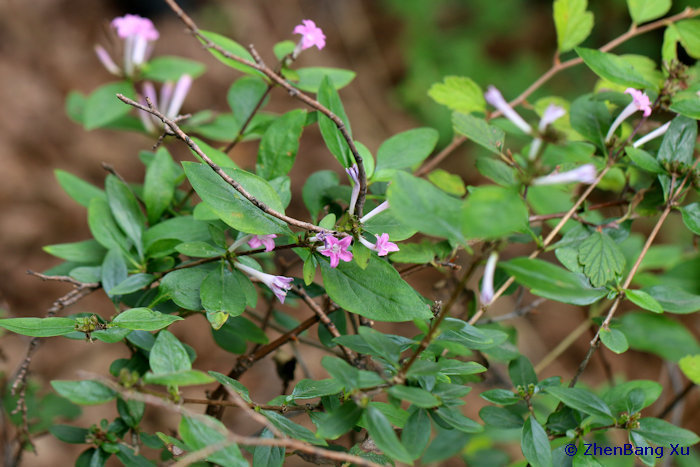
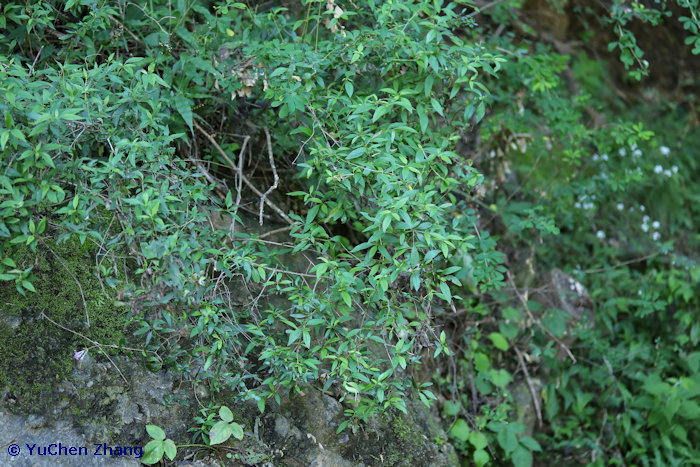
Unknown.
China: Beijing (Baihua Shan National Nature Reserve, 1400m; Huangshandian Village, Shangfangshan National Forest Park, 130m; Zhoukoudian Town, 100m; Beijing Botanical Garden; Yunmengshan National Forest Park; Xiaolongmen Forest Farm, 1100m; Yue'an Mountain Forestry Centre of the Beijing University of Agriculture, Sidaohe Village, Baoshan Town, 800m); Hebei (Taihang Shan).
This new subspecies has only recently been recorded west of Beijing, but this may indicate that Neogurelca montana may occur all along the edge of the Tibetan Plateau, from Yunnan to Beijing (Xu ZhenBang, pers. comm. 2020 & 2021; Xu, He, Yang, Kitching & Hu, 2023). In China, montane populations recorded as Neogurelca himachala (Butler, [1876]) should be checked carefully to make sure they are not Neogurelca montana.
Endemic to northeastern China.
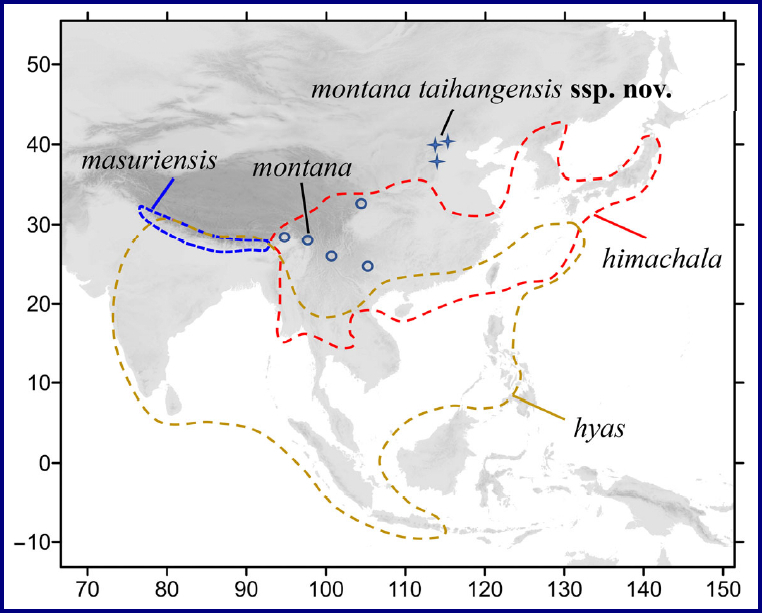
Map: Distribution of species of genus Neogurelca in Asia. The ranges of three species are represented by dashed lines. The blue circles indicate the populations of N. montana montana in Yunnan and Sichuan, the blue stars indicate the populations of N. montana taihangensis in Beijing and Hebei (© Xu, He, Yang, Kitching & Hu, 2023).
 Return to Sphingidae of the Eastern Palaearctic species list
Return to Sphingidae of the Eastern Palaearctic species list